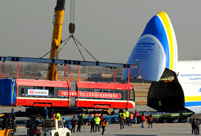The Britain-based risk analysis firm Maplecroft said South Asia and Southeast Asian countries are the most vulnerable to climate related disasters. This, Maplecroft said, poses obstacles to their sustained growth, and will hurt the poor the most as they're not likely have the resources to cope with these disasters.
Benson said there are several things that can be done now to prepare and mitigate losses that will be caused by disasters.
"We can begin by assessing disaster risk, drawing on local knowledge and experience as well as hazard maps and understanding the risk in our communities. We can take measures to ensure that our schools, homes, places of work and so forth are resilient, both by undertaking structural measures and through environmental measures," she said.
According to Preety Bhandari, head of ADB's Climate Change Program Coordination Units, governments across the board have included climate change plan into their development plans and are aware that climate change can influence growth.
Bhandari also welcomed the ASEAN countries' increased cooperation on disaster management and transboundary haze monitoring and their implementation of ASEAN Action Plan for Joint Response on Climate Action.
"This is a sign of their (ASEAN members) commitment and maturity in taking collective action," she said.
Bhandari, however, believes that global investment is needed to mitigate the damages caused by climate change.
She said the most important achievement in the recent UN climate talks is the establishment of an international mechanism to address loss and damage from impacts of climate change even if there were no new financial commitments or a road map to reach the 100 billion U.S. dollar target for this mechanism.
"But the call for a very significant scale of initial funding for the Green Climate Fund and additional pledges for Adaptation Fund is very much welcome," she said.

 Heavy cargo flights taking off
Heavy cargo flights taking off In pictures: PLA's digital equipment
In pictures: PLA's digital equipment  Americans mark Thanksgiving Day with parades
Americans mark Thanksgiving Day with parades Self-made farmer billionaire donates 69 villas at hometown
Self-made farmer billionaire donates 69 villas at hometown Demolition of bizarre rooftop villa in Beijing still in progress
Demolition of bizarre rooftop villa in Beijing still in progress Service seminar for E China train attendants
Service seminar for E China train attendants  China's first nude photographer
China's first nude photographer Selected sports photos of the week
Selected sports photos of the week Treasure of Chinese culture- Nuo Dance
Treasure of Chinese culture- Nuo Dance  Youths in Night club: photo story
Youths in Night club: photo story Models dazzle at Int'l Yacht Model Pageant
Models dazzle at Int'l Yacht Model Pageant  Crystal scenery in China: Jilin fog glaze
Crystal scenery in China: Jilin fog glaze  Tianjin holds first pole dance championship
Tianjin holds first pole dance championship  Annual Santa Claus parade held in Canada's Montreal
Annual Santa Claus parade held in Canada's Montreal China's aircraft carrier passes through Taiwan Strait
China's aircraft carrier passes through Taiwan StraitDay|Week|Month